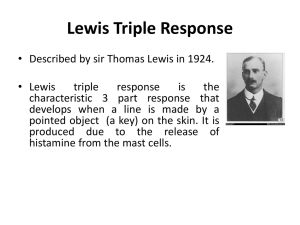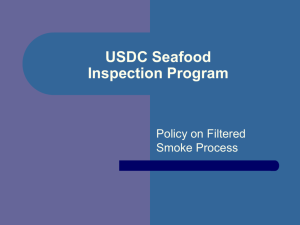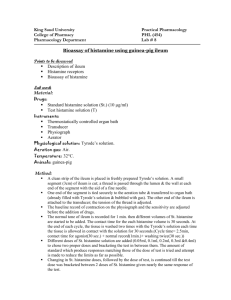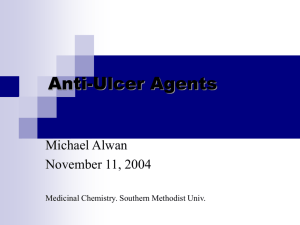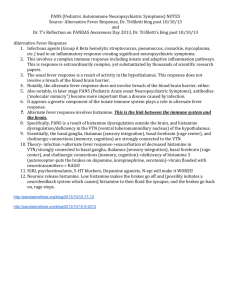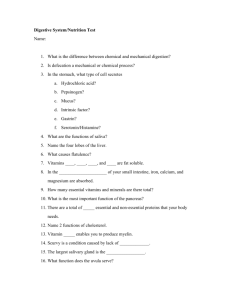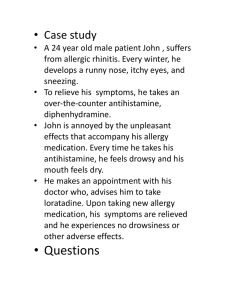Changes in Scomberotoxin (Histamine) and Volatile Thunnus tonggol
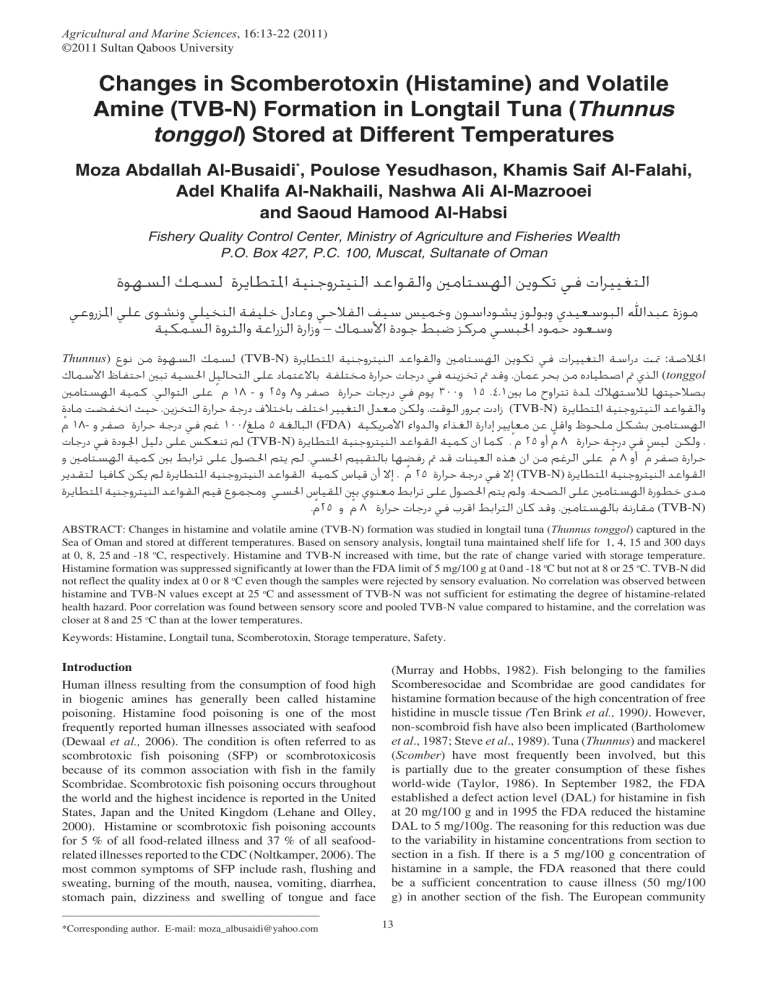
Agricultural and Marine Sciences , 16:13-22 (2011)
©2011 Sultan Qaboos University
Changes in Scomberotoxin (Histamine) and Volatile
Amine (TVB-N) Formation in Longtail Tuna ( Thunnus tonggol ) Stored at Different Temperatures
Moza Abdallah Al-Busaidi
*
, Poulose Yesudhason, Khamis Saif Al-Falahi,
Adel Khalifa Al-Nakhaili, Nashwa Ali Al-Mazrooei and Saoud Hamood Al-Habsi
Fishery Quality Control Center, Ministry of Agriculture and Fisheries Wealth
P.O. Box 427, P.C. 100, Muscat, Sultanate of Oman
ةﺓﻮﻬﺴﻟاﺍ ﻚﻤﺴﻟ ةﺓﺮﻳﺎﻄﺘﳌاﺍ ﺔﻴﻨﺟوﻭﺮﺘﻴﻨﻟاﺍ ﺪﻋاﺍﻮﻘﻟاﺍوﻭ ﲔﻣﺎﺘﺴﻬﻟاﺍ ﻦﻳﻮﻜﺗ ﻲﻓ تﺕاﺍﺮﻴﻴﻐﺘﻟاﺍ
ﻲﻋوﻭرﺭﺰﳌاﺍ ﻲﻠﻋ ىﻯﻮﺸﻧوﻭ ﻲﻠﻴﺨﻨﻟاﺍ ﺔﻔﻴﻠﺧ لﻝدﺩﺎﻋوﻭ ﻲﺣﻼﻔﻟاﺍ ﻒﻴﺳ ﺲﻴﻤﺧوﻭ نﻥﻮﺳاﺍدﺩﻮﺸﻳ زﺯﻮﻟﻮﺑوﻭ يﻱﺪﻴﻌﺳﻮﺒﻟاﺍ ﷲاﺍﺪﺒﻋ ةﺓزﺯﻮﻣ
ﺔﻴﻜﻤﺴﻟاﺍ ةﺓوﻭﺮﺜﻟاﺍوﻭ ﺔﻋاﺍرﺭﺰﻟاﺍ ةﺓرﺭاﺍزﺯوﻭ – كﻙﺎﻤﺳﻷاﺍ ةﺓدﺩﻮﺟ ﻂﺒﺿ ﺰﻛﺮﻣ ﻲﺴﺒﳊاﺍ دﺩﻮﻤﺣ دﺩﻮﻌﺳوﻭ
Thunnus ) عﻉﻮﻧ ﻦﻣ ةﺓﻮﻬﺴﻟاﺍ ﻚﻤﺴﻟ (TVB-N) ةﺓﺮﻳﺎﻄﺘﳌاﺍ ﺔﻴﻨﺟوﻭﺮﺘﻴﻨﻟاﺍ ﺪﻋاﺍﻮﻘﻟاﺍوﻭ ﲔﻣﺎﺘﺴﻬﻟاﺍ ﻦﻳﻮﻜﺗ ﻲﻓ تﺕاﺍﺮﻴﻴﻐﺘﻟاﺍ ﺔﺳاﺍرﺭدﺩ ﺖﲤ : ﺔﺻﻼﳋاﺍ
كﻙﺎﻤﺳﻷاﺍ ظﻅﺎﻔﺘﺣاﺍ ﲔﺒﺗ ﺔﻴﺴﳊاﺍ ﻞﻴﻟﺎﺤﺘﻟاﺍ ﻰﻠﻋ دﺩﺎﻤﺘﻋﻻﺎﺑ ﺔﻔﻠﺘﺨﻣ ةﺓرﺭاﺍﺮﺣ تﺕﺎﺟرﺭدﺩ ﻲﻓ ﻪﻨﻳﺰﺨﺗ ﰎ ﺪﻗوﻭ ،نﻥﺎﻤﻋ ﺮﺤﺑ ﻦﻣ هﻩدﺩﺎﻴﻄﺻاﺍ ﰎ يﻱﺬﻟاﺍ ( tonggol
ﲔﻣﺎﺘﺴﻬﻟاﺍ ﺔﻴﻤﻛ .ﻲﻟاﺍﻮﺘﻟاﺍ ﻰﻠﻋ ْﹾ مﻡ ١٨ وﻭ ٢٥وﻭ ٨وﻭ ﺮﻔﺻ ةﺓرﺭاﺍﺮﺣ تﺕﺎﺟرﺭدﺩ ﻲﻓ مﻡﻮﻳ ٣٠٠وﻭ ١٥ ،٤،١ﲔﺑ ﺎﻣ حﺡوﻭاﺍﺮﺘﺗ ةﺓﺪﳌ كﻙﻼﻬﺘﺳﻼﻟ ﺎﻬﺘﻴﺣﻼﺼﺑ
ةﺓدﺩﺎﻣ ﺖﻀﻔﺨﻧاﺍ ﺚﻴﺣ ،ﻦﻳﺰﺨﺘﻟاﺍ ةﺓرﺭاﺍﺮﺣ ﺔﺟرﺭدﺩ فﻑﻼﺘﺧﺎﺑ ﻒﻠﺘﺧاﺍ ﺮﻴﻴﻐﺘﻟاﺍ لﻝﺪﻌﻣ ﻦﻜﻟوﻭ ،ﺖﻗﻮﻟاﺍ رﺭوﻭﺮﲟ تﺕدﺩاﺍزﺯ (TVB-N) ةﺓﺮﻳﺎﻄﺘﳌاﺍ ﺔﻴﻨﺟوﻭﺮﺘﻴﻨﻟاﺍ ﺪﻋاﺍﻮﻘﻟاﺍوﻭ
ْﹾمﻡ ١٨ وﻭ ﺮﻔﺻ ةﺓرﺭاﺍﺮﺣ ﺔﺟرﺭدﺩ ﻲﻓ ﻢﻏ ١٠٠ / ﻎﻠﻣ ٥ ﺔﻐﻟﺎﺒﻟاﺍ (FDA) ﺔﻴﻜﻳﺮﻣﻷاﺍ ءﺀاﺍوﻭﺪﻟاﺍوﻭ ءﺀاﺍﺬﻐﻟاﺍ ةﺓرﺭاﺍدﺩإﺇ ﺮﻴﻳﺎﻌﻣ ﻦﻋ ﻞﻗاﺍوﻭ ظﻅﻮﺤﻠﻣ ﻞﻜﺸﺑ ﲔﻣﺎﺘﺴﻬﻟاﺍ
تﺕﺎﺟرﺭدﺩ ﻲﻓ ةﺓدﺩﻮﳉاﺍ ﻞﻴﻟدﺩ ﻰﻠﻋ ﺲﻜﻌﻨﺗ ﻢﻟ (TVB-N) ةﺓﺮﻳﺎﻄﺘﳌاﺍ ﺔﻴﻨﺟوﻭﺮﺘﻴﻨﻟاﺍ ﺪﻋاﺍﻮﻘﻟاﺍ ﺔﻴﻤﻛ نﻥاﺍ ﺎﻤﻛ .ْﹾ مﻡ ٢٥ وﻭأﺃ ْﹾمﻡ ٨ ةﺓرﺭاﺍﺮﺣ ﺔﺟرﺭدﺩ ﻲﻓ ﺲﻴﻟ ﻦﻜﻟوﻭ ،
وﻭ ﲔﻣﺎﺘﺴﻬﻟاﺍ ﺔﻴﻤﻛ ﲔﺑ ﻂﺑاﺍﺮﺗ ﻰﻠﻋ لﻝﻮﺼﳊاﺍ ﻢﺘﻳ ﻢﻟ .ﻲﺴﳊاﺍ ﻢﻴﻴﻘﺘﻟﺎﺑ ﺎﻬﻀﻓرﺭ ﰎ ﺪﻗ تﺕﺎﻨﻴﻌﻟاﺍ هﻩﺬﻫ نﻥاﺍ ﻦﻣ ﻢﻏﺮﻟاﺍ ﻰﻠﻋ ْﹾمﻡ ٨ وﻭأﺃ ْﹾمﻡ ﺮﻔﺻ ةﺓرﺭاﺍﺮﺣ
ﺮﻳﺪﻘﺘﻟ ﺎﻴﻓﺎﻛ ﻦﻜﻳ ﻢﻟ ةﺓﺮﻳﺎﻄﺘﳌاﺍ ﺔﻴﻨﺟوﻭﺮﺘﻴﻨﻟاﺍ ﺪﻋاﺍﻮﻘﻟاﺍ ﺔﻴﻤﻛ سﺱﺎﻴﻗ نﻥأﺃ ﻻإﺇ ، ْﹾمﻡ ٢٥ ةﺓرﺭاﺍﺮﺣ ﺔﺟرﺭدﺩ ﻲﻓ ﻻإﺇ (TVB-N) ةﺓﺮﻳﺎﻄﺘﳌاﺍ ﺔﻴﻨﺟوﻭﺮﺘﻴﻨﻟاﺍ ﺪﻋاﺍﻮﻘﻟاﺍ
ةﺓﺮﻳﺎﻄﺘﳌاﺍ ﺔﻴﻨﺟوﻭﺮﺘﻴﻨﻟاﺍ ﺪﻋاﺍﻮﻘﻟاﺍ ﻢﻴﻗ عﻉﻮﻤﺠﻣوﻭ ﻲﺴﳊاﺍ سﺱﺎﻴﻘﳌاﺍ ﲔﺑ يﻱﻮﻨﻌﻣ ﻂﺑاﺍﺮﺗ ﻰﻠﻋ لﻝﻮﺼﳊاﺍ ﻢﺘﻳ ﻢﻟوﻭ .ﺔﺤﺼﻟاﺍ ﻰﻠﻋ ﲔﻣﺎﺘﺴﻬﻟاﺍ ةﺓرﺭﻮﻄﺧ ىﻯﺪﻣ
. ْﹾمﻡ٢٥ وﻭ ْﹾمﻡ ٨ ةﺓرﺭاﺍﺮﺣ تﺕﺎﺟرﺭدﺩ ﻲﻓ بﺏﺮﻗاﺍ ﻂﺑاﺍﺮﺘﻟاﺍ نﻥﺎﻛ ﺪﻗوﻭ ،ﲔﻣﺎﺘﺴﻬﻟﺎﺑ ﺔﻧرﺭﺎﻘﻣ (TVB-N)
ABSTRACT: Changes in histamine and volatile amine (TVB-N) formation was studied in longtail tuna ( Thunnus tonggol ) captured in the
Sea of Oman and stored at different temperatures. Based on sensory analysis, longtail tuna maintained shelf life for 1, 4, 15 and 300 days at 0, 8, 25 and -18 o C, respectively. Histamine and TVB-N increased with time, but the rate of change varied with storage temperature.
Histamine formation was suppressed significantly at lower than the FDA limit of 5 mg/100 g at 0 and -18 o C but not at 8 or 25 o C. TVB-N did not reflect the quality index at 0 or 8 o C even though the samples were rejected by sensory evaluation. No correlation was observed between histamine and TVB-N values except at 25 o C and assessment of TVB-N was not sufficient for estimating the degree of histamine-related health hazard. Poor correlation was found between sensory score and pooled TVB-N value compared to histamine, and the correlation was closer at 8 and 25 o C than at the lower temperatures.
Keywords: Histamine, Longtail tuna, Scomberotoxin, Storage temperature, Safety.
Introduction
Human illness resulting from the consumption of food high in biogenic amines has generally been called histamine poisoning. Histamine food poisoning is one of the most frequently reported human illnesses associated with seafood
(Dewaal et al., 2006). The condition is often referred to as scombrotoxic fish poisoning (SFP) or scombrotoxicosis because of its common association with fish in the family
Scombridae. Scombrotoxic fish poisoning occurs throughout the world and the highest incidence is reported in the United
States, Japan and the United Kingdom (Lehane and Olley,
2000). Histamine or scombrotoxic fish poisoning accounts for 5 % of all food-related illness and 37 % of all seafoodrelated illnesses reported to the CDC (Noltkamper, 2006). The most common symptoms of SFP include rash, flushing and sweating, burning of the mouth, nausea, vomiting, diarrhea, stomach pain, dizziness and swelling of tongue and face
__________________________________________________
*Corresponding author. E-mail: moza_albusaidi@yahoo.com
13
(Murray and Hobbs, 1982). Fish belonging to the families
Scomberesocidae and Scombridae are good candidates for histamine formation because of the high concentration of free histidine in muscle tissue ( Ten Brink et al., 1990 ) . However, non-scombroid fish have also been implicated (Bartholomew et al ., 1987; Steve et al ., 1989). Tuna ( Thunnus ) and mackerel
( Scomber ) have most frequently been involved, but this is partially due to the greater consumption of these fishes world-wide (Taylor, 1986). In September 1982, the FDA established a defect action level (DAL) for histamine in fish at 20 mg/100 g and in 1995 the FDA reduced the histamine
DAL to 5 mg/100g. The reasoning for this reduction was due to the variability in histamine concentrations from section to section in a fish. If there is a 5 mg/100 g concentration of histamine in a sample, the FDA reasoned that there could be a sufficient concentration to cause illness (50 mg/100 g) in another section of the fish. The European community
Al-Busaidi and others established that the average content of histamine in fish should not exceed 10 mg/100 g and no sample may contain more than 20 mg/100 g for fish belonging to Scombridae,
Clupeidae, Engraulidae, Coryphaenidae, Pomatomidae and Scomberesocidae families (Commission Regulation
2073/2005/EC). Omani legislation (Ministerial Decision
No.12/2009) has specified that histamine should not exceed
10 mg/100 g. Shalaby (1996) recommended the following guideline levels for histamine content of fish: <5 mg/100 g
(safe for consumption): 5-20 mg/100 g (possibly toxic);
20-100 mg/100 g (probably toxic) and >100 mg/100 g (toxic and unsafe for consumption). Knowledge of the proximate composition of fish species has fundamental importance in the application of different technological processes and it is also an important aspect of the quality of raw material, sensory characteristics and storage stability
(Sikorski, 1994). One of the most common chemical methods used for quality evaluation of fresh seafood is the evaluation of the total volatile bases fraction (TVB-
N). The TVB-N includes ammonia, monoethylamine, dimethylamine along with trimethylamine (Yeh et al .,
1978). Omani legislation (Ministerial Decision No.12/
2009) has specified the TVB-N level for good quality fish is 25-35 mg/100 g.
Tuna and tuna-like species are important due to their global economic importance and international trade for canning and sashimi, and are mostly consumed locally as fresh, frozen or canned. Longtail tuna ( Thunnus tonggol ) is one of the popular pelagic fish and accounts for a large proportion of fish production in the Sultanate of Oman.
Although the fish has been rarely implicated in outbreaks of scombroid poisoning, there have been concerns for potential formation of histamine, since it belongs to the scombroid family, contains high level of histidine in the muscle and has high body temperature (26-30 o C). Many studies have reported on the effect of storage temperature on histamine formation for various tuna species but results very often have been ambiguous with the level of histamine formation and shelf-life. (Guillen-Velasco et al ., 2004; Silva et al ., 1998; Guizani et al ., 2005).
Also, there is little or no knowledge relating to histamine levels in longtail tuna under various storage conditions.
Histamine was measured and compared with volatile base nitrogen and sensory analysis in order to assess the effect of storage time and temperature.
Materials and Methods
Sample Collection and Storage
The fish samples used for the trials were 102 fresh longtail tuna ( Thunnus tonggol ) caught from the Sea of Oman and purchased at the landing centre, Muscat,
Sultanate of Oman. Fish samples were stored on ice and kept in thermocole boxes and delivered to the laboratory within 45 minutes from the landing centre.
Upon arrival at the laboratory, the length and weight of the fish were measured. The tuna fish were divided into four groups. One group (n=30) was stored at 0 o C in ice (ice temperature). The second group (n=27) of fish was stored at 8 o C (home refrigeration temperature) in a temperature-monitored refrigerator. The third group (n=6) was stored at 25 ± 2 o C (room temperature representing the winter ambient temperature of Muscat and surrounding regions). The fourth group (n=36) of fish was stored at
-18 o C (frozen storage temperature) using a temperaturemonitored-cooled incubator. Fish were placed individually in separate clean polythene bags and stored at respective temperatures. Good Manufacturing Practices (GMP) and
Good Hygienic Practices (GHP) were strictly followed during the handling and storage at different temperatures of raw samples in order to avoid microbial growth and post-catch contamination. During storage, melting ice was replenished everyday in order to maintain a constant storage temperatures in ice-stored samples. Temperature was monitored regularly throughout the storage period with a digital thermometer.
Physical, chemical and sensory tests were performed on fresh longtail tuna samples prior to storage at different temperatures. Sampling was carried out at predetermined time intervals depending on the temperature of storage.
Samples stored at 25, 8 and 0 o C were analyzed on a daily basis. However, it is known that the deterioration progresses slowly at freezing temperatures, therefore, samples stored at -18 o C were analyzed twice a week at the beginning of the storage and thereafter at two-month intervals for a period of up to 10 months. Triplicate samples were used for each analysis.
Proximate analysis
Moisture, ash, fat, and protein were determined following the AOAC (1993) methodologies (Sec 950.46, 938.08,
960.39, and 955.04, respectively).
Histamine analysis
Histamine was determined by the method of Taylor et al.
(1978) with some modifications. Fish muscle (10 g) was homogenized with 20 ml of 10% trichloroacetic acid (TCA) using a homogenizer (Nissei, Japan) for 2-3 min. The homogenate was centrifuged at 3000 rpm for
5 min and 20 ml of the supernatant was filtered through a Whatman membrane filter and the pH 5-7 was adjusted using a 10 % sodium hydroxide solution. Twenty ml of 0.4
M acetic acid buffer was added to the pH adjusted solution and filtered through a column containing amberlite with
100 ~200 mesh size (CG50). The column was washed with 80 ml of 0.2 M acetic acid buffer and 20 ml of 0.2
N HCl. A total volume of 25 ml was collected, filtered through a Whatman (0.45 µm) membrane filter and 20 µl was directly injected into the chromatograph.
The analysis was performed using a Waters Alliance
High-Pressure Liquid Chromatography System (HPLC) model 2690 equipped with a quaternary pump, an online degasser and an injection valve with a loop capacity of
20 µl. The detector used was a Scanning Fluorescence
14
Changes in scomberotoxin and volatile amine formation in longtail tuna stored at different temperatures
15
Al-Busaidi and others
14
Changes in scomberotoxin and volatile amine formation in longtail tuna stored at different temperatures
Detector model 474 with a 330 nm excitation and 430 nm emission wavelengths. The histamine compound was determined using a reverse phase Shodex Asahipak column model ODP-50 (150 x 4.6 mm). The isocratic mobile phase (18:82) consisted of acetonitrile (Sigma,
99.9 %) and 50 mM Sodium tetraborate (Sigma, 99 %) aqueous solution containing 1 mM O-phtal-aldehyde
(OPA) (GR for fluorometry, Kiran light laboratory) and
1mM NAC (N-Acetyl-l-cysteine) was used at a flow rate of 0.5 ml/min. The histamine peaks were integrated and calculated with Empower software. For each analysis, recovery samples were prepared and analysed and the mean recovery obtained was 95.5 %. Also, standard reference material of FAPAS canned tuna fish (SRM
T 2711) was used to cross-check the reliability of the test. The mean value (125 ± 6.5 mg/100 g) was within the range of the assigned value (138 ± 17.0 mg/100 g) of histamine showed that the method was adequate for the analysis of histamine.
Total Volatile Base Nitrogen (TVB-N) analysis
TVB-N was determined using the method of Damoglu
(1979). Fish muscle (10 g) was homogenized with 150 ml of distilled water, 2 g magnesium oxide, and 4 drops of silicon antifoam agent for 1 min. using a Warring blender.
The homogenate was transferred into a receiving flask and
25 ml of 2 % boric acid and 3 drops of methyl red indicator were added and the flask was placed into a BUCHI steam distillation unit consisting of Rotavapor model R-124,
Vacuum controller model B-721 and Water-bath model
B-480 (Switzerland). The mixture was steam distilled,
75 ml of the volatile component collected and the level determined by titrating with 0.05 N sulfuric acid (H
2
SO
4
).
Sensory evaluation
Sensory analysis was carried out by 7 semi-trained panelists. The panel evaluated the fish samples based on a hedonic scale with numerical scores of 7-1, 5-1 or
3-1 point scale using the assessment scheme from the
Tasmanian Food Research Unit with slight modifications
(Bremmer et al ., 1987; Guizani et al ., 2005). The inherent characteristics of longtail tuna such as gill colour, gill odour, round body, overall appearance, eye colour were evaluated (Table 1). Scores among panelists were averaged and tested statistically.
Statistical analysis
Results of physical, chemical and sensory analysis were analyzed using SPSS 10.0 (SPSS INC., Chicago,
IL) software. Descriptive statistics of means, standard deviation, one way and two-way ANOVA, and correlation coefficient (Pearson’s) were applied in analyzing the results. A significance level of 5 % was used. The regression analysis between parameters was conducted by plotting scattered graphs and calculating the r 2 factors.
The r 2 factors higher than 0.5 were accepted to indicate a correlation between chemical and sensory parameters.
Results
Proximate Composition
The average length and weight were 46.18 + 2.03 cm and 1.03 + 0.125 kg, respectively. The results of the proximate composition of longtail tuna at different storage temperatures are presented in Table 2. The initial values for moisture, lipid, crude protein and ash were 72.5, 2.85,
23.19 and 1.52 %, respectively. In the present study, the values reported for moisture (71.45, 71.25, 71 and 73.05
%), lipid (3.02, 3.22, 4.48 and 2.62 %), protein (23.89,
24.0, 23.15 and 23.02 %) and Ash (1.38, 1.4, 1.43 and 1.30
%) in longtail tuna stored at 0, 8, 25 and -18 o C at the end of the storage are shown in Table 2. Significantly (p<0.05) low loss of moisture was observed for tuna stored at -18 o C, and the loss was higher at 25 o C compared to 0 and 8 o C. The final values for moisture content in all the storage temperatures were significantly lower (p<0.05) than the initial value. Reduction in fat content was noticed at -18 o C, however, unlike moisture content, 25 o C resulted in a higher fat content. At the end of the storage period 0,
8, 25 and -18 o C showed significantly higher values for fat content than the initial value. Protein contents did not change significantly for the longtail tuna fish at different storage temperatures. However, tuna fish stored at -18 and
8 o C showed less and more protein contents, respectively, at the end of the storage. Final values for ash contents were significantly lower in all the storage temperatures than their initial value. There were only minor differences among 0, 8 and 25 o C for ash contents, however, -18 o C exhibited a significantly (p<0.05) lower ash content.
Changes in Histamine Concentration
The histamine content of longtail tuna was negligible (0.2 mg/100g) at the beginning of the experiment, as shown in
Figure 1. Histamine production was strongly suppressed at 0 o C and no increase in the histamine concentration was observed up to day 4. Thereafter, the formation of histamine showed some fluctuations with time; however, increase in the histamine content was noticed from day 7 onwards, with the highest concentration of 4.808 mg/100 g on day 11. A reduction in the amount of histamine was observed at the end of the storage on day 15, reaching a value of 0.4 mg/100 g. In this study, the histamine in longtail tuna muscle during the storage at 0 o C was lower than 5 mg/100 g even at the end of the storage (Fig. 1). An increase in histamine content was delayed for the longtail tuna at the refrigerated temperature of 8 o C for the first three days reaching a value of 0.984 mg/100 g, which was slightly higher than the value reported at 0 o C. However, histamine significantly increased (p<0.05) on day 7 and rapidly increased on day 8, reaching a value of 17.99 mg/
100 g of fish and maintained until the end of the storage on day 10. The values were nearly four times higher than the value reported for longtail tuna stored at 0 o C. In contrast to the refrigeration temperature, histamine levels increased very rapidly at 25 o C, reaching 28.40 mg/100 g of tuna in
15
Al-Busaidi and others
Table 1.
Sensory assessment data sheet for longtail tuna ( Tunnus tonggol ).
Serial No.
1
2
3
4
5
Physical Characteristics
General
Eyes
Gills
Belly
Overall
Feature
Appearance of surface
Texture
Slime
Surface
Eyeball
Eye
Color
Odor
Slime
Condition
Acceptance
Sensory Feature
Very bright
Moderately bright
Slightly bright
Neither bright nor dull
Slightly dull
Moderately dull
Very dull
Firm
Soft
(Rank between 7 and 1)
Very clear
Very slimy
(Rank between 7 and 1)
Not sunken
Slightly sunken
Sunken
Very clear
Moderately clear
Slightly clear
Neither clear nor cloudy
Slightly cloudy
Moderately cloudy
Very cloudy
Bright, clear intact
Bloody damaged
Bright red
Deep dark red
Dull red
Pale brown
Bleached
Seaweedy
Neutral
Slightly fishy
Fishy
Ammonia (putrid odor)
Very clear
Very slimy
(Rank between 7 and 1)
Intact
Burst (Rank between 7 and 1)
Very acceptable
Moderately acceptable
Slightly acceptable
Neither acceptable nor rejected
Slightly rejected
Moderately rejected
Very rejected
16
3
2
1
5
4
3
2
5
4
1
7
1
5
4
3
7
6
2
1
3
2
1
3
2
1
7
1
Score
3
2
1
7
6
5
4
7
1
7
1
Changes in scomberotoxin and volatile amine formation in longtail tuna stored at different temperatures
17
Al-Busaidi and others
16
Changes in scomberotoxin and volatile amine formation in longtail tuna stored at different temperatures
Table 2. Changes in the proximate composition in longtail tuna ( Tunnus tonggol ) stored at different temperatures.
Storage days
60
120
180
14
18
30
240
300
4
7
9
0
1
3
4
7
0
1
2
8
9
10
9
10
11
14
15
3
4
7
8
0
1
0
1
2
Moisture(%)
Mean ± SD
72.50 ± 0.50
73.60 ± 0.10
70.95 ± 0.25
74.30 ± 0.10
73.70 ± 0.40
73.20 ± 0.28
71.15 ± 0.25
72.25 ± 0.25
71.25 ± 0.15
72.50 ± 0.50
71.90 ± 0.70
71.00 ± 0.11
72.50 ± 0.50
73.00 ± 0.63
72.10 ± 0.55
73.30 ± 0.30
73.30 ± 0.90
73.70 ± 0.10
73.55 ± 0.45
73.30 ± 0.20
73.40 ± 0.23
71.65 ± 0.35
72.15 ± 0.35
72.50 ± 0.20
73.05 ± 0.75
72.50 ± 0.50
74.05 ± 0.34
75.30 ± 0.20
73.20 ± 0.55
71.05 ± 0.05
73.55 ± 0.35
73.15 ± 0.65
71.75 ± 1.25
72.05 ± 0.65
71.65 ± 1.75
71.45 ± 0.28
25.05 ± 0.02
23.89 ± 0.11
8 o C
23.19 ± 0.05
23.33 ± 0.02
23.24 ± 0.02
21.82 ± 0.01
23.29 ± 0.23
23.12 ± 0.31
24.37 ± 0.23
24.21 ± 0.15
24.00 ± 0.19
25 o C
23.19 ± 0.05
23.12 ± 0.03
23.15 ± 0.26
Protein (%)
Mean ± SD
0 o C
23.19 ± 0.05
23.03 ± 0.04
21.67 ± 0.01
23.62 ± 0.41
24.06 ± 0.09
23.10 ± 0.58
23.11 ± 0.32
24.75 ± 0.14
24.72 ± 0.37
-18 o C
23.19 ± 0.05
23.15 ± 0.42
23.11 ± 0.25
23.62 ± 0.11
23.35 ± 0.80
23.77 ± 0.17
22.31 ± 0.01
23.09 ± 0.04
23.06 ± 0.14
23.52 ± 0.27
24.65 ± 0.12
23.42 ± 0.03
23.02 ± 0.61
Fat (%)
Mean ± SD
2.85 ± 0.06
2.96 ± 0.02
2.86 ± 0.04
2.39 ± 0.01
2.55 ± 0.09
2.05 ± 0.35
2.46 ± 0.06
2.62 ± 0.08
2.93 ± 0.04
3.29 ± 0.02
2.82 ± 0.04
3.15 ± 0.07
2.62 ± 0.05
2.85 ± 0.06
2.49 ± 0.06
3.08 ± 0.02
2.89 ± 0.10
2.59 ± 0.03
3.24 ± 0.08
3.29 ± 0.06
3.03 ± 0.02
3.22 ± 0.01
2.85 ± 0.06
2.37 ± 0.02
2.48 ± 0.01
2.41 ± 0.01
3.10 ± 0.03
2.61 ± 0.04
2.69 ± 0.09
2.80 ± 0.03
2.70 ± 0.02
2.84 ± 0.01
3.02 ± 0.09
2.85 ± 0.06
3.69 ± 0.02
4.48 ± 0.02
Ash (%)
Mean ± SD
1.52 ± 0.03
1.56 ± 0.01
1.49 ± 0.01
1.38 ± 0.04
1.37 ± 0.04
1.38 ± 0.08
1.41 ± 0.01
1.30 ± 0.03
1.40 ± 0.01
1.52 ± 0.03
1.51 ± 0.01
1.34 ± 0.01
1.35 ± 0.02
1.47 ± 0.01
1.40 ± 0.04
1.37 ± 0.01
1.40 ± 0.02
1.46 ± 0.32
1.12 ± 0.01
1.38 ± 0.02
1.52 ± 0.03
1.43 ± 0.01
1.43 ± 0.01
1.52 ± 0.03
1.50 ± 0.01
1.40 ± 0.09
1.47 ± 0.03
1.43 ± 0.04
1.42 ± 0.06
1.51 ± 0.03
1.46 ± 0.01
1.53 ± 0.05
1.59 ± 0.06
1.55 ± 0.02
1.54 ± 0.01
1.30 ± 0.04
17
Al-Busaidi and others
A
25.00
20.00
15.00
10.00
5.00
0.00
HISTAM INE
0 1 3 4 7 8 9 10 11 14 15
B
25.00
20.00
15.00
10.00
5.00
0.00
0
TVB N HISTAMINE
1 2 3 4 7
Storage time (days)
8 9 10
C
70.00
60.00
50.00
40.00
30.00
20.00
10.00
0.00
TVB N HISTAMINE
D
25.00
20.00
15.00
10.00
5.00
0.00
0 1 4 7 9 1 18 30 60
0 1
Storage time (days)
2
Figure 1 . Changes in Histamine and TVB-N in longtail tuna stored at (A) 0 o C, (B) 8 o C (C), 25 o C and (D) -18 o C.
one day of storage. The concentrations became 290 and 15 times higher than the histamine concentration reported at 0 and 8 o C, respectively, and reached 34.99 mg/100 g of tuna at the end of the storage on day 2. No significant changes
(p>0.05) in the histamine concentrations were observed during frozen storage at -18 o C for a period of one month.
Thereafter, a significant increase (p<0.05) was observed during the second month reaching a level of 3.04 mg/100g and decreased up to month eight. At the end of the storage period, a slight increase in the histamine concentration was observed. Safety with respect to the histamine was maintained for nearly 10 months in this experiment.
to the refrigerated samples, the TVB-N value increased sharply on day 1 for the longtail tuna stored at 25 o C reaching a value of 12.59 mg/100 g and at the end of the storage period the value reached a level of 62.12 mg/100 g which is above the rejection limit of 40 mg/100 g set for
TVB-N (Directive 95/149/EEC).
Sensory Evaluation
According to the sensory analysis, the initial samples were of good quality, indicated by the value for raw tuna of 6.3 ±
0.51 (Fig. 2). The mean sensory score and standard deviation for overall acceptance of longtail tuna is depicted in Figure
2. Storage temperature significantly (p<0.05) influenced the overall acceptance and limited the shelf life of longtail tuna to 15, 4 and less than one day during storage at 0, 8
25 o and
C, respectively. The overall acceptance was nearly 10 months for longtail tuna stored under frozen storage.
Total Volatile Base Nitrogen (TVB-N)
The initial TVB-N value for fresh longtail tuna was 2.741 mg/100 g of fish in keeping with the quality of very fresh fish. An increasing trend in TVB-N was noticed in all the samples with storage time but the increase was not linear except in samples stored at 8 o C (r 2 = 0.880) and 25 o C
(r 2 = 0.968). A significant increase (p <0.05 %) in TVB-N was noticed on day 1 and the value reached 11.03 mg/100 g on day 10, thereafter, a slight decrease was observed at the end of storage period for fish stored at 0 o C. At a temperature of 8 o C, the TVB-N values increased more rapidly on day one (reaching a value of 7.35 mg/100 g) and increased slowly but fluctuated with time reaching a maximum value of 21.99 mg/100 g on day 9. At the end of the storage period the value was 16.98 mg/100 g. A slow increase in the TVB-N was observed for samples stored at -18 o C reaching a maximum value of 17.98 mg/100 g.
A slight reduction in the TVB-N was observed at the end of the storage. The values were always below the level of
30-40 mg/100 g declared for good quality fish. In contrast
Discussion
Proximate Composition
In the present study, the values of proximate composition were within the range reported earlier for commercial-size tuna fish in different waters (Mazorra-Manzano et al .,
2000; Begona et al ., 2006). Generally, storage time and temperature significantly (p<0.05) affect the proximate composition. Begona et al.
(2006) reported a low loss of moisture for tuna fish stored at -18 o C.
Histamine Concentration
Generally, histamine production showed different patterns at the four different storage temperatures, which indicates that storage temperature may have an effect on histamine
18
Changes in scomberotoxin and volatile amine formation in longtail tuna stored at different temperatures
19
Al-Busaidi and others
18
Changes in scomberotoxin and volatile amine formation in longtail tuna stored at different temperatures
8
7
6
5
4
3
2
1
0
0 oC 8 oC 25 oC
B
8
7
6
5
4
3
2
1
0
0 1 4 7 9 14 18 30 60 120 180 240 300
Storage time (days)
0 1 2 3 4 7 8
Storage time (days)
9 10 11 14 15
Figure 2.
Changes in Sensory score (overall acceptance) of longtail tuna during storage at (A) 0, 8 and 25 o C and (B) -18 o C. production. Also, fluctuation with time was noticed in all the storage temperatures. Silva et al.
(1998) reported
<0.1 mg/100 g of histamine for bigeye tuna species and skipjack tuna species at the beginning of their study. Our findings agree with that study, and the concentration was well below the FDA limit of 5 mg/100 mg. Storage temperatures significantly inhibited the formation of histamine at 0 and 8 o C. The reduction of histamine with time of storage could be due to its decomposition once it was produced (Guizani et al ., 2005). Sato et al.
(1994) reported that the histamine formation also depends on the presence of histamine decomposition bacteria within the flora along with histamine forming bacteria. They noticed that, initially, histamine accumulated in the fish stored at 5 o C and then the levels started decreasing and disappearing when the count of histamine decomposing bacteria exceeded 10 6 cells/g. It could also be due to the histaminases activity in the spoilage bacteria that may be responsible for the decline observed in longtail tuna after
11 days. Lopez-Sabater et al . (1995) found in bigeye tuna that histamine content declined once it reached its maximum level. However, in our study, notable amounts were not detected for up to 15 days of storage in ice.
Safety of longtail tuna with respect to the histamine for up to four days at 8 o C agreed well with that of bigeye tuna, where four days at the same temperature were reported by
Lopez-Sabater et al.
(1995).
The histamine formation was increased at a faster rate in the longtail tuna samples stored at 25 o C. Increase in histamine formation is assumed to occur as a result of the growth of psychrotrophic or psychrophilic bacteria
(Bennour et al ., 1991; Vagelis et al ., 2007). Stratton and Taylor (1991) stated that, the enteric bacteria are the most prolific histamine producers in fish when they are maintained at temperatures greater than 4 o C. Also, once the enzyme histidine decarboxylase has been formed, it can be active at or near refrigeration temperatures (FDA, 2001).
Storage at 25 o C encouraged the rapid histamine formation reaching the toxicity level within one day. This could be due to mesophiles, which are the most prolific histamine formers. In addition, histidine decorboxylase activity is favored at temperatures higher than 15 o C. Lehane and
Olley (2000) correlated the rapid histamine formation at 20 o C with the growth of Proteus morganii , which was found to grow better and to be the main histamine producer at 24-30 at 0 o o C. Unlike histamine decomposition
C, no decomposition took place at 25 o C, which implies that, such a high temperature might inhibit the growth of histamine decomposing bacteria (Sato et al .,
1994). Our results agreed well with previous findings by
Silva et al . (1998) and Guizani et al . (2005) who found rapid histamine accumulation in bigeye tuna, skip jack tuna and yellow fin tuna where safety was maintained for only one day at 22 and 20 o C, respectively. It is possible that components, chemical or enzymatic, break down the biogenic amines faster than they can be produced at these temperatures, but then the components responsible for breaking down biogenic amines are either used up, or inactivated, whereas the enzymes producing biogenic amines remain active for a longer period of time. The histamine formation was very slow for the tuna samples stored at -18 o C. Storage time at frozen temperatures strongly controlled the formation of histamine. This could be due to the freezing temperature, which probably kills the freeze sensitive histamine producing bacteria (Ben-
Gigirey et al ., 1998). At the same time, a slight increase in histamine concentration at this temperature could be due to the retention of histidine decorboxylase activity in frozen tuna which may increase histamine on thawing.
The histamine concentration in tuna at 0 and -18 o C were lower than the health hazard level of 5 mg/100 g, fixed by the FDA (2001), and the legal limit of 10 mg/100 g fixed by European Community and Omani regulations.
However, at 8 and 25 o C the histamine levels were above the allowable limit after four days and 24 hrs, respectively, and characterized as unsuitable for consumption. Shakila et al . (2003) found a histamine content above the FDA maximum allowable limit of 5 mg/100 g after 12 hrs in
Rastrelliger kanagurta and after 15 hrs in Sardinella fimbriata stored at ambient temperature (32 o C).
The safe shelf life of scombrotoxin forming species is dependent upon the harvesting methods, the onboard handling and the time/temperature exposures throughout the processing, transit and storage. There are several factors affecting the probability of occurrence of histamine fish poisoning and among them, post-catch
19
Al-Busaidi and others contamination, inadequate chill storage or freezing and thawing procedures can be listed (Lehane and Olley,
2000). In fish subjected to elevated temperatures even for shorter periods, a large population of bacteria is soon established. During subsequent refrigeration, although bacterial growth ceases, residual enzyme activity continues slowly and histamine levels can increase
(Stratton and Taylor, 1991). In this study, tuna showed histamine concentrations defined as safe for consumption at 0 and -18 stored at 8 o C, possibly toxic and probably toxic when and 25 o C, respectively.
TVB-N
Significant differences (p<0.05) in TVB-N values were observed for longtail tuna stored at 0 and 8 o C. This was probably due to the influence of storage temperatures.
Among the four different storage temperatures, slow increases in the levels of TVB-N were observed for longtail tuna stored at -18 o C; followed by 0 o C. The relatively low increase in the TVB-N value could be due to the effectiveness of low temperatures on the growth of TVB-N producing bacteria. Maximum amounts and rapid increase were found for the longtail tuna samples kept at 25 o C; which indicates that, ambient temperature favoured the growth of TVB-N producing bacteria. Silva et al . (1998) reported 64 mg/100 g of TVB-N for skipjack tuna at 22 o C at the end of the storage period on third day. Connell (1990) reported that a maximum of 35-40 mg/100 g is usually regarded as the limit of acceptability; however, in the present study TVB-N values for tuna samples were well within the suggested limit throughout the storage period, except, for samples stored at 25 o C.
Figure 1 shows the TVB-N values obtained during the storage period at different temperatures. TVB-N values were found to increase linearly with time at 8 (r 2 =0.880) and 25 o C (r 2 =0.968). However, an insignificant (p>0.05) increment in TVB-N values was observed with time at 0 and -18 o C, which could denote low bacterial activity. Our results were in agreement with the observation made by
Mazorra-Manzano et al.
(2000) for skipjack tuna muscle during iced storage. According to our results, changes in
TVB-N content during storage of tuna at 0 and 8 o C did not reflect the quality index even though the samples were rejected by sensory evaluation.
Sensory Evaluation
Fish were rejected by the panel members very early even though the TVB-N value did not exceed the limit of 30-40 mg/100 g. Figure 3 shows the relationship of the overall acceptability of fish by sensory evaluation with pooled values of TVB-N and histamine.
Poor correlation (r 2 =0.472) was observed between overall acceptance and pooled TVB-N value during storage at four different temperatures indicating that the fish was rejected by the sensory panel before the fish reached the stage of decomposition. At the same time, correlation (r 2 =0.647) was observed between sensory score and histamine formation and the correlation was greater at 8 (r 2 = 0.717) and 25 o C (r 2 = 0.948). However, no correlation was found at 0 o and -18 o C. These results agreed with Guizani et al.
(2005) who reported a linear relationship between sensory score and histamine for yellowfin tuna stored at the same temperature. During storage at 0 o C longtail tuna were rejected by the panelists before histamine reached a toxic level of 5 mg/100 g fish
(FDA, 2001). This observation agreed with the findings of
Guizani et al . (2005) for storage of tuna fish at 0 o C and
Lopez at 8 o et al.
(1995) for storage of tuna at 0 o C; however,
C the fish maintained its safety up to the fourth day, that was well correlated with sensory score for overall acceptance. The loss of shelf life of longtail tuna correlated with the loss of safety with respect to histamine formation of longtail tuna when stored at 8 and 25 o C. However, tuna stored at 0 and -18 o C maintained their safety throughout the storage period. This could be due to decomposition of histamine at this temperature. The optimum temperature for the majority of the histamine formers is 25 o C.
Regression analysis of histamine and other quality characteristics of longtail tuna revealed a correlation between histamine concentrations and sensory analysis at 8 and 25 o C; but not at 0 or -18 o C, even though the fish were rejected by the sensory panel. No correlation was observed between histamine and TVB-N formation, except, at 25 o C
(r 2 =0.699). Measurements of volatile basic nitrogen were not adequate for estimating the extent of a histaminerelated health hazard. It was found that decomposition of longtail tuna at all the storage temperatures progressed faster than histamine formation.
Conclusion
Histamine and volatile amine (TVB-N) increased progressively during storage, but the rate of change varied with temperature. Histamine production was suppressed significantly (p<0.05) and lower than the FDA maximum allowable limit of 5 mg/100 g at 0 and -18 o C. With regard to the histamine toxicity, histamine production was very high at 8 and 25 o C. Taking into consideration public health safety, appropriate storage temperature at preferably <4 o
C and appropriate handling of tuna fish are necessary for delaying histamine production and preventing histamine poisoning outbreaks. Also, freezing the tuna prior to processing and storage reduced the histamine production.
The histamine content did not show any correlation with the TVB-N value except, at 25 o C. However, the o correlation was closer with sensory changes at 8 and 25
C. TVB-N did not indicate the degree of freshness for fish stored at low temperatures (0 and -18 o C). Estimation of TVB-N was not adequate for estimating the degree of histamine-related health hazards. The refrigeration temperature during storage is very critical to reducing histamine formation and also it is necessary to determine histamine content in order to control a potential health hazard. The loss of shelf life of longtail tuna correlated with the loss of safety with respect to histamine formation
20
Changes in scomberotoxin and volatile amine formation in longtail tuna stored at different temperatures
21
Al-Busaidi and others
20
Changes in scomberotoxin and volatile amine formation in longtail tuna stored at different temperatures
7.000
6.000
5.000
4.000
3.000
2.000
1.000
0.000
0.000
y = 0.0973x + 5.8435
R² = 0.4724
10.000
20.000
30.000
40.000
TVB N mg/100g
50.000
60.000
70.000
A
7.000
6.000
5.000
4.000
3.000
2.000
1.000
0.000
0.000
y = 0.1335x + 5.4309
R² = 0.6473
B
10.000
20.000
Histamine mg/kg
30.000
40.000
70.000
60.000
50.000
40.000
30.000
20.000
10.000
0.000
0.000
y = 1.2245x
R² = 0.2697
C
C
10.000
20.000
Histamine mg/kg
30.000
40.000
Figure 3.
Relationship between (A) sensory score and TVB-N, (B) sensory score and histamine, and (C) TVB-N and histamine of longtail tuna stored at 0, 8, 25 and -18 o C.
at 8 and 25 o C; however, tuna stored at 0 and -18 maintained their safety throughout the storage period.
Acknowledgements o C
We would like to thank Mehdia Al-Zidjali, Alia Al-Zidjali and Nada Al-Abri of Fishery Quality Control Centre,
Oman, for their constant assistance and contribution in sample preparation and analysis during this project.
References
AOAC. 1993. Official Methods of Analysis,14 th Ed.
Vol. II. Association of Official Analytical Chemists.
Arlington, Va. Chap 35:1-8.
Bartholomew, B.A., P.R. Berry, J.C. Rodhouse, R.J.
Gilbert, and C.K. Murray. 1987. Scombrotoxic fish poisoning in Britain: features of over 250 suspected incidents from 1976 – 1986. Epidemiology and
Infection 99:775-782.
Ben-Gigirey,B., J.M. Vieites Bapista De Sousa, T.G.
Villa, and J. Barros-Velasquez. 1998. Changes in biogenic amines and microbiological analysis in albacore ( Tunnus alalunga ) muscle during frozen storage. Journal of Food Protection 61:608-615.
Begona, B.G., M. Juan, B.D.S. Vieites, G. Tomas, and
G.B.V. Villa. 2006. Chemical changes and visual appearance of Albacore Tuna as related to frozen storage. Journal of Food Science 64:20-24.
21
Al-Busaidi and others
Bennour, M.E.L., A. Marrakchi, N. Bouchriti, A. Hamama, and M. El Quasea. 1991. Chemical and microbiological assessments of mackerel ( Scomber scombrus ) stored in ice. Journal of Food Protection 54:789-792.
Bremmer, H.A., J. Olley, and A.M.A. Vail. 1987.
Estimating time temperature effect on rapid systematic sensory method. In: Proceedings of an International
Symposium on Seafood Quality Determination , D.E.
Kramer and J.Liston (Editors), 413-434. Alaska, USA,
Amsterdam:Elsevier.
Commission Regulation 2073/2005/EC of 15 November
2005. 2005 Official Journal L 338/1, 22/12/2005.
Connel, J.J. 1990. Methods of Assessing and Selecting for Quality. In: Control of Fish Quality (3 rd Edition),
122–150, Fishing News Books, Oxford.
Damoglu, A.P. 1979. A comparison of different methods of freshness assessment of herring. In: Advances in Fish
Science and Technology . Paper presented at the Jubilee
Conference of the Torry Research Station, Aberdeen,
Scotland, 22-23 July 1979. Fish Review Books Ltd.
Farnham, Surrey, England. 394-399.
Dewaal, C.S., G. Hicks, K. Barlow, L. Alderton, and
L. Vegosen. 2006. Foods associated with foodborne illness outbreaks from 1990 till 2003 . Food Protection
Trends 26:466-473.
Food and Drug Administration (FDA). 2001. Scombrotoxin
(histamine) formation. In: Fish and Fisheries Products
Hazards and Controls Guidance , (3 rd Edition), 83-102,
Office of Seafood, Washington, DC.
Guillen-Velasco, S., E. Ponce-Alquicira, A. Farres-
Gonzalez Saravia, and I. Gerrero-Legarreta. 2004.
Histamine production by two enterobacteriaceae strains from tuna ( Thunnus thynnus ) and jack mackerel
( Trachurus murphyii ). International Journal of Food
Properties 7:91-103.
Guizani, N., M.A. Al-Busaidy, I.M. Al-Belushi, A.
Mothershaw, and M.S. Rahman. 2005. The effect of storage temperature on histamine production and freshness of yellowfin tuna ( Thunnus albacares ). Food
Research International 38:215-222.
Lehane, L. and J. Olley. 2000. Review: histamine fish poisoning revisited. International Journal of Food
Microbiology 58:1-37.
Lopez-Sabater, E., J. Rodrigues-Jerez, M. Hernadez-
Herrrero, A. Roig-Sagues, and M. Mora-Ventura.
1995. Sensory quality and histamine formation during controlled decomposition of tuna ( Thunnus thynnus ).
Journal of Food Protection 59:167-174.
Mazorra-Manzano, M.A., R. Pacheco-Aguilar, E.I. Diaz-
Rojas, and M.E. Lugo- Sanchez. 2000. Post mortem changes in black skipjack muscle during storage in ice.
Journal of Food Science 65:774-779.
Ministerial Decision No.12/2009. 2009. Fisheries Quality
Control Regulation, Ministry of Fisheries Wealth,
Muscat, Sultanate of Oman.
Murray, C.K. and G. Hobbs. 1982. Scombrotoxin and scombrotoxin-like poisoning from canned fish. Journal of Hygiene 88:215-220.
Noltkamper, D. 2006, Toxicity, marine-histamine in fish,
[eMedicin]. Available at: http://www.emedicine.com/ ped/topic1012.htm. Accessed November 19, 2007.
Sato,T., T. Fujii, T. Masuda, and M. Okuzumi. 1994.
Changes in number of histamine metabolic bacteria and histamine content during storage of common mackerel.
Fisheries Science 60:299-302.
Sikorski, Z.E. 1994. The Myofibrillar Proteins in Seafood.
In: Seafood Proteins , Z.E. Sikorski, B.S. Pan and F.
Shahidi (Editors), Chapman and Hall, New York.
Shalaby, A.R. 1996. Significance of biogenic amines to food safety and human health. Food Research
International 29:675-690.
Shakila, R.J., K. Vijayalakshmi, and G. Jeyasekaran.
2003. Changes in histamine and volatile amines in six commercially important species of fish of the
Thoothukkudi coast of Tamilnadu, India stored at ambient temperature. Food Chemistry 3:347-352.
Silva, C., D. Ponte, and M. Dapkevicius. 1998. Storage temperature effect on histamine formation in big eye tuna and skipjack tuna. Journal of Food Science 63:
644-647.
Steve, L.T., E.S. Jayne, and A.N. Julie. 1989. Histamine poisoning (Scombroid Fish Poisoning): an allergy-like intoxication. Clinical Toxicology 27:225-240.
Stratton, J.E. and S.L. Taylor. 1991. Scombroid poisoning.
In: Microbiology of Marine Food Products , D. Ward and C. Hackney (Editors), 331-351, Spectrum, New
York, N.Y.
Taylor, S., E. Lieber, and M. Leatherwood. 1978.
A simplified method for histamine analysis of foods.
Journal of Food Science 43:247-50.
Taylor, S.L. 1986. Histamine food poisoning - Toxicology and clinical aspects . Critical Reviews in Toxicology 17:
91-128.
Ten Brink, B., C. Damink, H.M.L.J. Joosten, and J.H.J.
Huis In’T Veld. 1990. Occurrence and formation of biologically active amines in foods. International
Journal of Food Microbiology 11:73-84.
Yeh, C.P.S., R. Nickelson II, and G. Finne. 1978.
Ammonia producing enzymes in white shrimp tails.
Journal of Food Science 43:1400-1401.
Received: October 3, 2010
Accepted: February 20, 2011
22
